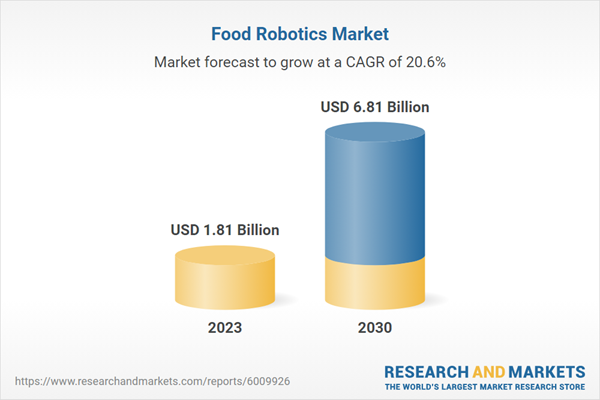The industry has witnessed increasing investments in R&D activities, since the past few years, for the development of technologically-advanced robotics and automated systems. The increasing labor costs are driving the packaged food producers toward the adoption of automation systems. The application segments of the market include palletizing, packaging, repackaging, picking, and processing.
The packaging segment is presumed to hold the highest growth rate over the forecast years. The market is witnessing increasing use of packaging automation solutions in food industries. The advantages bestowed by the technology include higher efficiency in food production and processing, increased production efficiency, and consistent quality of products.
The key market participants IN the food robotics market are ABB Group,Kawasaki Heavy Industries Ltd., Fanuc Corporation, Yaskawa Electric Corporation, and others. The vendors in the robotics and automation market are likely to witness increased demand for robotics solutions over the forecast years, owing to the increasing technological advancements.
Food Robotics Market Report Highlights
- Articulated robots dominated the market and accounted for a market revenue share of 41.9% in 2023. The growth is attributed to the articulated robot's structure and design, which mimics a human arm's movements.
- The medium payload segment accounted for the largest revenue share in 2023. Medium payload capability robots address applications such as selecting, repackaging, packing, and transferring.
- The palletizing segment dominated the global industry in 2023. Robots are commonly used for packaging or stacking the food onto pallets for warehousing or transportation.
- Europe's food robotics market dominated the global industry and accounted for a revenue share of 30.6% in 2023. It is attributed to the regulations concerning food safety, the rising labor costs in the region, and the growing inclination towards the automation of multiple processes in the food industry.
- The Asia Pacific food robotics market is anticipated to witness the fastest growth during the forecast period. The rising disposable income of customers in emerging economies is driving the demand for packaged and processed food, which in turn is fueling the need for automation technologies to improve food production capacities.
The leading players in the Food Robotics market include:
- ABB
- KUKA AG
- Kawasaki Heavy Industries, Ltd.
- FANUC CORPORATION
- Rockwell Automation
- YASKAWA ELECTRIC CORPORATION
- DENSO CORPORATION
- Mitsubishi Electric Corporation
- Universal Robots A/S
- JR Automation (Hitachi, Ltd.)
Why should you buy this report?
- Comprehensive Market Analysis: Gain detailed insights into the global market across major regions and segments.
- Competitive Landscape: Explore the market presence of key players worldwide.
- Future Trends: Discover the pivotal trends and drivers shaping the future of the global market.
- Actionable Recommendations: Utilize insights to uncover new revenue streams and guide strategic business decisions.
This report addresses:
- Market intelligence to enable effective decision-making
- Market estimates and forecasts from 2018 to 2030
- Growth opportunities and trend analyses
- Segment and regional revenue forecasts for market assessment
- Competition strategy and market share analysis
- Product innovation listing for you to stay ahead of the curve
- COVID-19's impact and how to sustain in these fast-evolving markets
This product will be delivered within 1-3 business days.
Table of Contents
Companies Mentioned
The leading players in the Food Robotics market include:- ABB
- KUKA AG
- Kawasaki Heavy Industries, Ltd.
- FANUC CORPORATION
- Rockwell Automation
- YASKAWA ELECTRIC CORPORATION
- DENSO CORPORATION
- Mitsubishi Electric Corporation
- Universal Robots A/S
- JR Automation (Hitachi, Ltd.)
Methodology

LOADING...
Table Information
| Report Attribute | Details |
|---|---|
| No. of Pages | 100 |
| Published | September 2024 |
| Forecast Period | 2023 - 2030 |
| Estimated Market Value ( USD | $ 1.81 Billion |
| Forecasted Market Value ( USD | $ 6.81 Billion |
| Compound Annual Growth Rate | 20.6% |
| Regions Covered | Global |
| No. of Companies Mentioned | 11 |









